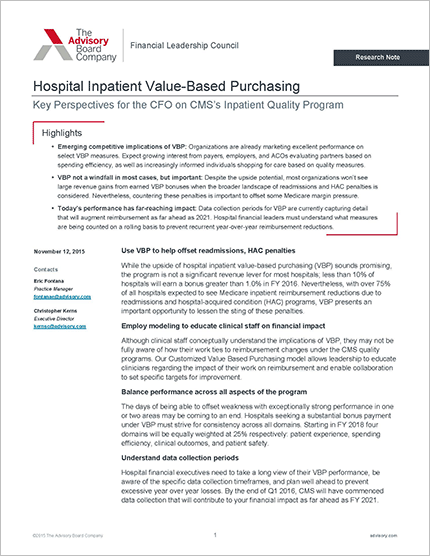CMS has released the final FY 2018 adjustments for the Readmissions Reduction Program (HRRP), the Value-Based Purchasing Program (VBP), and the Hospital-Acquired Conditions Reduction Program (HACRP). You can see how hospitals around the nation performed in our updated pay-for-performance map below, which reflects performance data from FYs 2013 to 2018, including trending for specific organizations.
CMS previously released FY 2018 data on the 2,573 hospitals that will face cuts under the Readmissions Reduction Program, as well as the penalties or bonuses under the VBP program for the 2,808 hospitals in the program.
Now, CMS has completed the FY 2018 pay-for-performance picture by identifying the 751 hospitals that will face Medicare payment cuts under HACRP.
Background on HACRP
The CFO's guide to value-based purchasing
HACRP evaluates hospitals based on their rates of several avoidable complications, such as bed sores, blood clots, central line infections, and falls. For FY 2017, CMS added two additional measures related to antibiotic-resistant bacteria:
- Rates of infection from methicillin-resistant Staphylococcus aureus, or MRSA; and
- Rates of infection from Clostridium difficile, or C. diff.
Under the program, which launched in October 2014, Medicare penalizes the 25% of hospitals that perform worst. During the current payment period, which runs from October 2017 to September 2018, the lowest-performing hospitals will have their Medicare payments reduced by 1%. Certain hospitals, such as those that treat veterans, children's hospitals, and critical access hospitals, are exempt from the payment cuts. Hospitals in Maryland are also exempt from the payment cuts, as Medicare compensates hospitals in that state differently.
Latest update
CMS under HACRP assessed the performance of 3,306 hospitals. Despite changes to HACRP's scoring methodology this year, there was relative stability in the cohort of penalized hospitals from FY 2017 to FY 2018: According to an analysis by Kaiser Health News, 425 hospitals penalized in FY 2018 were also penalized last year.
About one-third of the penalized hospitals are teaching hospitals—a smaller proportion than last year, when CMS levied penalties on nearly half of the country's teaching hospitals, KHN reports. In addition, according to the analysis, safety net hospitals were more likely than those that treated higher-income patients to be penalized for FY 2018, with about one-third of safety net hospitals assessed under HACRP being fined.
Comments
According to KHN, HACRP has been "controversial," with some patient advocates praising the penalties as a means of spurring improving care quality and some hospital stakeholders contending the penalties unfairly punish hospitals that treat a sicker patient population or are more skilled at identifying patient complications.
For instance, Kevin Kavanagh—board chair of Health Watch USA, a patient advocacy group—praised the program for being "instrumental in focusing hospitals on the problems of patient safety and improved quality."
Separately, Nancy Foster, VP for quality and patient safety at the American Hospital Association, voiced concerns about how the program penalizes the lowest-performing 25% of hospitals, even if those hospitals have improved their performance. Calling it a '"HACidental' payment policy,'" Foster explained, "The congressional mandate that a quarter of hospitals should be penalized every year creates this odd situation in which more than half of the hospitals being penalized have the same or relatively the same performance as many of the hospitals who escaped penalty," adding, "They ought to recognize improvement."
Atul Grover, EVP of the Association of American Medical Colleges, added that while teaching hospitals did better this year than last year, "we are still disproportionately affected" (Rau [1], Kaiser Health News, 12/21/17; Rau [2], Kaiser Health News, 12/21/17; Castellucci, Modern Healthcare, 12/21/17; Ellison, Becker's Clinical Leadership & Infection Control, 12/22/17)
Don't miss out on the latest Advisory Board insights
Create your free account to access 2 resources each month, including the latest research and webinars.
Want access without creating an account?
You have 2 free members-only resources remaining this month remaining this month.
1 free members-only resources remaining this month
1 free members-only resources remaining this month
You've reached your limit of free monthly insights
Become a member to access all of Advisory Board's resources, events, and experts
Never miss out on the latest innovative health care content tailored to you.
Benefits include:
You've reached your limit of free monthly insights


